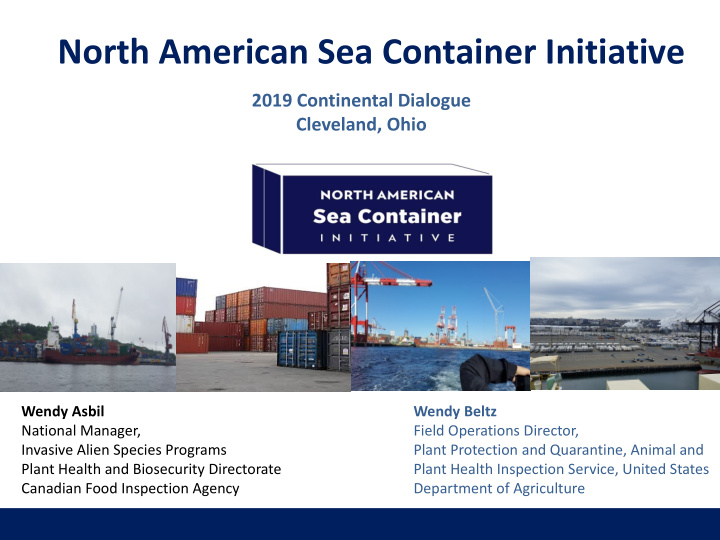



North American Sea Container Initiative 2019 Continental Dialogue Cleveland, Ohio Wendy Asbil Wendy Beltz National Manager, Field Operations Director, Invasive Alien Species Programs Plant Protection and Quarantine, Animal and Plant Health and Biosecurity Directorate Plant Health Inspection Service, United States Canadian Food Inspection Agency Department of Agriculture
Sea Containers: Biosecurity Risk? • Contaminated containers enter the United States and Canada every day • Containers then transported by rail and truck throughout the United States and Canada
Sea Containers • Over 35 million TEUs in global trade in 2016 • Move between many countries and carry many different commodities • Risk of contaminants of phytosanitary concern is on or in containers • Examples of pests or regulated articles found include: soil, plant debris, egg masses, Khapra beetle, leafhoppers, snails, and weed seeds
Cargo • Non-agriculture cargo: often not regulated under plant protection legislation (e.g. car parts, tiles, steel slabs) but contaminants are regulated (e.g. soil, snails, weed seeds, and live insects)
Container and Cargo Contamination How? Container, conveyance and cargo contamination can occur for many reasons such as: • soil-based staging, storage or handling areas • vegetation around storage, staging, packing • lights that attract insects (e.g. moths) • environmental factors (e.g. wind, rain) • packaging • previous cargo
Container and Cargo Contamination Why Do We Care? General • negative impact on agriculture, forestry sectors and environmental sectors and the livelihood, health and social well-being they provide • costs to manage are high – prevention is key • affects trade, international obligations, competitiveness Industry • regulatory actions • delays for cargo release, demurrage charges due to cargo holds, expense of having cargo quarantined, removed from North America, tarped, treated or cleaned Credit: Mark R. McNeill Photo: Lawrence Barringer gwood.org
North American Sea Container Initiative Voluntary Canada-United States government-industry initiative
North American Sea Container Initiative Mission Statement Industry and government working collaboratively to raise awareness, educate, and motivate participants along the supply chain to help reduce pest risks associated with sea containers and their cargos. Cleanliness matters Cleanliness protects Clean containers and clean cargos are good business Clean containers and clean cargos reduce inspections, expedite clearance, and result in lower costs to the sea container supply chain Ultimate Goal Safeguarding the world’s agriculture and natural resources and facilitating safe international trade by reducing pest risks from sea containers and their cargos.
North American Sea Container Initiative Objectives • Enhance understanding of challenges and opportunities for identifying and reducing pest risks in the sea container supply chain. • Enhance understanding of logistics of container movement in North America • Conduct outreach and education to our respective stakeholders, industries and organizations • Collect data to measure risk of pathway and effectiveness of outreach • Encourage global adoption of similar, voluntary programs through the International Plant Protection Convention and other relevant international and regional forums
North American Sea Container Initiative What’s been done so far • Identifying existing industry guidelines related to sea container cleanliness (e.g. Code of Practice for Packing of Cargo Transport Units (CTU Code), Joint Industry Guidelines for Cleaning of Containers) • Engaging industry groups on guidelines and programs for cargo (e.g. the Italian ceramic tile industry’s Good Phytosanitary Practices Program) • Working with government and industry to collect data to continue to measure biosecurity risks of sea container pathway • Outreach • Joint United States-Canada Sea Container Bulletin • Web page published on NAPPO website • Frequently Asked Questions document, logo, infographic, deck of slides, video • Participated in various government and industry forums and meetings
North American Sea Container Initiative
North American Sea Container Initiative What’s next • Continue to expand international awareness and potential adoption of this type of voluntary initiative • Continue outreach and education efforts • Continue to work with government and industry to collect data to continue to measure biosecurity risks of sea container pathway • Contribute to revision of CTU code plant health/cleanliness aspects
Working Together What We Can All Do • See it, say it • Do it – adopt best management practices such as CTU code, cleaning guidelines • Participate - spread the word that container cleanliness counts • Share ideas - how we can all better protect global plant resources
Working Together We Can • Better understand challenges and opportunities for risk identification and risk mitigation. • Minimize risk while maintaining trade flow • Conduct outreach and education to our respective industries and stakeholders shared risk = shared responsib ility
North American Sea Container Initiative Contacts Canada: Wendy Asbil National Manager, Invasive Alien Species Program Plant Health and Biosecurity Directorate Canadian Food Inspection Agency 613-773-7236 wendy.asbil@inspection.gc.ca United States: Wendy Beltz PPQ Field Operations Director 2150 Centre Blvd., Bldg. B Fort Collins, CO 80525 970-494-7564 Office 970-215-1048 Cell wendolyn.beltz@usda.gov
Resources Joint Bulletin https://www.aphis.usda.gov/aphis/ourfocus/planthealth/import- information/!ut/p/z1/fYxLD4IwEITv_AounhcSA3IkasBHPJdempXwqEJb2mL031sR9eZlZ2d3vgHq- b7nAXHilnl8FKjAG2_QcimwAwIFjdgpXGfBahkes- 0mDNI82R3yOArWSQz7Cfzxr4b_BJmJOf4VKPhlGGgKtJTCVncLBFXLDZussKzjZ436sQgMMjlqVstyNJN THbp_W2Fn2-nAeyW1fSfr2rRSV0xp2WjsHSHQlBzUlRZP_3f4ZQ!!/ http://inspection.gc.ca/plants/plant-pests-invasive-species/sea-container- cleanliness/eng/1508779809618/1508779809944 International Plant Protection Convention https://www.ippc.int/en/core-activities/governance/cpm/scientific-sessions-during-commission- phytosanitary-measures/2016-special-topic-session-sea-containers/ CTU Code https://www.unece.org/trans/wp24/guidelinespackingctus/intro.html Joint Industry Guidelines For Cleaning of Containers http://www.worldshipping.org/industry-issues/safety/joint-industry-guidelines-for-cleaning-of- containers
Thank you Comments, Questions, Discussion Biosecurity: Shared Risk – Shared Responsibility
Recommend
More recommend